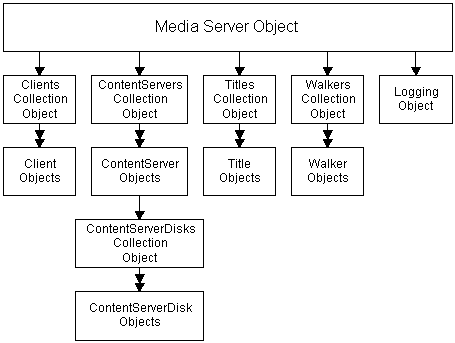[Previous][Next]
MediaServer Component Objects
In addition to the methods, properties, and events used for configuring and managing NetShow Theater Server systems, the MediaServer control also manages collections of component objects that encapsulate the status and behavior of clients, servers, disk drives, and titles. Some objects represent a collection of other objects. These component objects are:
- A Client object, which encapsulates the state of a client. It contains the identifier (ID) of the client, its IP address, the name of the title, if any, being streamed to the client, and the destination address (IP) or ATM Network Service Access Point (NSAP) of the funnel connection (whether the client is connecting through a proxy or not).
- A Clients object, which contains a collection of Client objects. As with all the collections, you can retrieve a Client member object by using its Item property, and query the total number of Client objects by using the Count property. You can also remove a Client object by calling its Remove method.
- A ContentServer object, which encapsulates the state of a content server. It holds information about its identifier, the content disk drives it manages, the host computer on which it is running, and its working status. A content server is accessible through its associated ContentServer object.
- A ContentServers object, which represents a collection of ContentServer objects. It can contain from one to fourteen such objects.
- A content server Disk object, which provides access to a content server disk drive dedicated to storing multimedia content. You can query the ID, its drive letter, the disk size, and the status, with the appropriate properties. You can take the disk online or offline by invoking its Online method, and repair the content on the disk by calling its Rebuild method.
- A content server Disks object, which represents a collection of Disk objects. You can retrieve a member Disk object with the Item property, and query the total number of member Disk objects with the Count property. Each ContentServer object manages a Disks collection.
- A Title object, which encapsulates the information about a multimedia title, including its description, author, copyright, size, version, format, play duration, and time at which it was created.
- A Titles collection object, which contains a number of Title objects. You can call its Add or Remove method to add a title to or remove one from the title server and the Titles collection.
- A Walker object, which encapsulates the information about file walker utilities used in the conversion of a title format.
- A Walkers collection object, which contains a number of Walker objects. In addition to exposing the Item and Count properties, it offers the Find functionality for searching a Walker object by matching its format type.
- A Logging object, which exposes methods and properties for managing event log monitoring applications.
The following diagram illustrates the hierarchy of objects managed by the MediaServer control.

[Previous][Next]
© 1996-1998 Microsoft Corporation. All rights reserved


